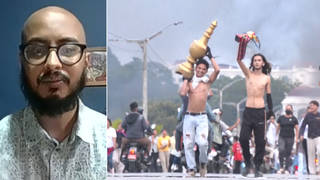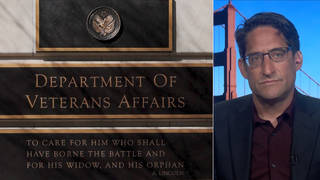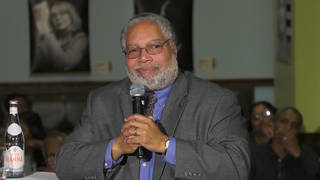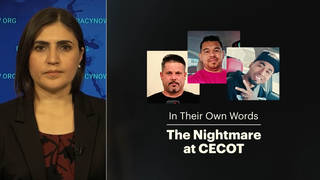
Topics
The death toll in Guatemala has mounted to 2,000 after mudslides buried whole villages caused by the torrential rains of Hurricane Stan. Although desperately in need of aid, villagers in Panabaj are refusing military assistance because of painful memories of a 1990 military massacre. We speak with human rights lawyer Jennifer Harbury about this haunting past, whose Mayan husband was killed by a Guatemalan officer on the CIA payroll. [includes rush transcript]
The death toll from devastating mudslides in Guatemala has reportedly topped 2,000 as rescuers called off their search for hundreds of people buried for six days under solidifying mud. The official death toll remains at 652, but authorities have now raised the number of homes in the country that were damaged, destroyed or threatened by new rain fall to 200,000–and the final number of dead is expected to rise dramatically. Many of those killed were buried alive when heavy rains following Hurricane Stan let loose an avalanche of mud, rocks and trees. Meanwhile, the threat of hunger and disease looms in many communities whose crops have been destroyed and water sources compromised.
Guatemalan President Oscar Berger visited the disaster zone in Panabaj Tuesday accompanied by Indian rights activist and Nobel peace prize winner Rigoberta Menchu. Berger promised that new housing and land would be provided away from the devastated area, which has been declared both a mass grave and a contamination zone. The government has been widely criticized for responding too slowly to the tragedy. In Panabaj, villagers were reportedly refusing to allow the Guatemalan army in because of haunting memories of a 1990 massacre by the military. Much of the region remains fearful of the Guatemalan military after 36 years of fighting that ended in 1996. During that time, Guatemala’s U.S backed state forces and allied paramilitary groups were responsible for the torture and murder of up to 200,000 people. Declassified US intelligence documents have shown that the CIA maintained close ties to the Guatemalan army throughout much of the 1980s and that U.S. officials were aware that the Guatemalan army and its paramilitary allies were massacring thousands of Mayan villagers. To talk more about the US role in Guatemala we are joined from Boston by human rights lawyer, Jennifer Harbury. Her husband, a Mayan guerrilla commander known as Commandante Everardo, was killed in the early 1990s by a Guatemalen officer on the CIA payroll.
- Jennifer Harbury, Director of the Unitarian Universalist Service Committee’s Stop Torture Permanently campaign. She is a human rights lawyer, author of “Searching for Everardo: A Story of Love, War & the CIA in Guatemala” and the new book “Truth, Torture and the American Way: The History and Consequences of U.S. Involvement in Torture”
Transcript
AMY GOODMAN: To talk more about the U.S. role in Guatemala and what the villagers are afraid of right now, we’re joined by Jennifer Harbury, human rights attorney. She’s in Boston now. Her husband, a Mayan comandante, known as Comandante Everardo, was killed by a Guatemalan officer on the CIA payroll. And she has written a new book, called Truth, Torture and the American Way: The History and Consequences of U.S. Involvement in Torture. Welcome to Democracy Now!, Jennifer.
JENNIFER HARBURY: Thank you, Amy.
AMY GOODMAN: We are hearing in the media about the mudslide and about the horror in Guatemala, but not the man-made part of the horror that has made the situation worse, the fear of the Guatemalan villagers of having the military come in to help them. Can you explain what happened in 1990?
JENNIFER HARBURY: Well, in 1990, there was a massacre in the town of Santiago Atitlan, which is one of larger indigenous villages on the lake itself. Panabaj and many others are tiny villages, which surround that and are also on the edge of the lake. All of them throughout the 1980s and 1990s suffered horrible repression at the hands of the Guatemalan military, which the United Nations in its Truth Commission Report found guilty of genocide against the indigenous people.
1990 was one of the last very serious massacres in Santiago Atitlan. Basically, the villagers saw one too many of their friends being dragged away by the army to the local military base, where he was clearly going to be tortured and killed, just like everybody else had been over the last twenty years. So, what they did was they rang the church bells, and all of the villagers went to the front of the military base and demanded that the man be released, and not, quote/unquote, “disappeared.”
The army responded by opening fire on the crowd, which included men, women, children, and elderly. And several dozen people were very seriously wounded, and quite a few were killed, including children. This, of course, like I say, followed a rampage of killings, torture and disappearances that had been going on since the late 70s and early 80s. It was in Santiago Atitlan, for example, that Father Stan Rother, an American priest working there for many years, was shot to death in the sacristy, much like Archbishop Romero was in El Salvador.
Literally, so many people were being dragged away in the middle of the night, then being left dead and mutilated either in the town square or tossed into unmarked graves that people were sleeping in the cornfields. They were afraid to sleep in their house. Or they would gather by the hundreds and sleep in the church. This is a region of terror. Trying to send the army in to help out would be a little bit like sending in, you know, former SS guards to plant trees in Israel. It’s just not going to work. And for good reason.
AMY GOODMAN: Right now, you have come out with your book, Truth, Torture, and the American Way, and held a kind of mock trial in Washington, the weekend of the major anti-war protests. Can you talk about your linking of the massacres then to the issue of torture today, from Guantanamo to Abu Ghraib, Jennifer Harbury?
JENNIFER HARBURY: Certainly. What I do in the book is show that the types of torture, the very horrible things that we’re seeing in the photographs out of Abu Ghraib, like the use of dogs, holding people in water pits in the Afghan file, the water boarding things, the stress and duress positions, the excruciating positions, sleep deprivation, etc., etc., that those are very standard CIA torture techniques that were used all over Latin America, including Guatemala. In my husband’s case, for example, was the water pit. That’s in his files. People in Retalhuleu Military Base were held in water pits with the water so deep they had to hold on to overhead bars to keep from drowning.
But what I also show in the book is not only that the exact same techniques were used, but that very often there were North Americans walking in and out of the torture cells themselves, which, of course, is a very different thing from what we were told during those decades, which was that we were just trying to professionalize the army, make sure they had good weaponry, etc., etc., but we had no participation in the death squad activities or the torture or massacres that were occurring.
In my husband’s case, of course, we learned far too late for him and for hundreds of thousands of others that the CIA, in fact, had many of the worst torturers and human rights violators in Guatemala and the rest of the western hemisphere on their payroll as paid informants. In other words, the people torturing my husband got money in return for turning over whatever they heard. During one of the worst torture sessions, for example, Colonel Julio Roberto Alpirez that same month received $44,000 from the CIA. They rushed that remarkable amount of money out to a remote jungle area to give him the cash.
But on top of that, now we find that not only did we pay these people to give us information extracted through torture, we were even going in and out of the torture cells, and sadly, I notice that where a lot of Mayan villages were massacred in Guatemala, some 660, in fact, according to the UN Truth Commission Report, that’s with 300 people — men, women, children and elderly — being hacked to death and tossed into mass graves or thrown into ravines in a single afternoon. I note that the CIA files show that they were very aware of all of that and did not report it to even the intelligence oversight committees in Congress.
Not only that, they didn’t warn people. For example, there is a very sad notation in one of the CIA files that’s now been declassified and, I believe, can be viewed at the National Security Archives, and it simply notes that there was a meeting at which many of the military leadership decided that they were going to sweep through a certain Mayan village area. This was at the height of the massacre campaign. And no warning apparently went out because the next notation says, ’Oh, yes, many, many people were killed there. There was a massacre, but no guerillas were found. There was mostly just villagers. So apparently the CIA knew this was about to occur, gave no warning and then did not report it afterwards. Most of the State Department reports, in fact, to our Congress, which was supposed to be monitoring the human rights situations, were extremely slanted.
AMY GOODMAN: Jennifer Harbury, author of Truth, Torture and the American Way, Director of the Unitarian Universalist Service Committee’s Stop Torture Permanently campaign. We’re going to go to break. When we come back, we’re going to go to the mock trial you held in Washington and hear testimony of Sister Dianna Ortiz. Thank you for joining us, Jennifer.












Media Options